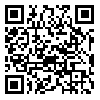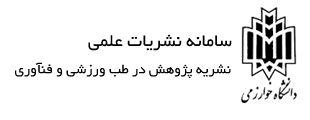دوره 22، شماره 28 - ( 10-1403 )
جلد 22 شماره 28 صفحات 189-173 |
برگشت به فهرست نسخه ها
Download citation:
BibTeX | RIS | EndNote | Medlars | ProCite | Reference Manager | RefWorks
Send citation to:



BibTeX | RIS | EndNote | Medlars | ProCite | Reference Manager | RefWorks
Send citation to:
Ghazaleh L, Salar F, sharifi F. Comparing The Effect Of Fatigue Induced By Endurance Running And Sprinting On The Knee Muscles Co-Contraction In Active Young Women: With The Approach Of Identifying The Origin Of Fatigue. RSMT 2024; 22 (28) :173-189
URL: http://jsmt.khu.ac.ir/article-1-635-fa.html
URL: http://jsmt.khu.ac.ir/article-1-635-fa.html
غزاله لیلا، سالار فرحناز، شریفی فاطمه. مقایسه اثر خستگی ناشی از دو سرعت و دوی استقامت بر هم انقباضی عضلات زانو در زنان جوان فعال: با رویکرد تشخیص منشأ خستگی. پژوهش در طب ورزشی و فناوری. 1403; 22 (28) :173-189
استادیار گروه فیزیولوژی ورزشی، دانشکده علوم ورزشی، دانشگاه الزهرا، تهران، ایران. ، L.ghazaleh@alzahra.ac.ir
چکیده: (3871 مشاهده)
هدف پژوهش حاضر مقایسه اثر خستگی ناشی از دو سرعت و دو استقامت بر هم انقباضی عضلات زانو در زنان جوان فعال بود. روششناسی: سیزده زن جوان فعال (20-30 سال، BMI 20-25kg/m2)، بر اساس معیارهای پژوهش به طور تصادفی انتخاب شدند. آزمودنیها طی دو جلسه با فاصله زمانی چهار روز، پروتکلهای خستگی را اجرا کردند. فعالیت عضلات پهن داخلی و پهن خارجی، بهوسیله دستگاه الکترومایوگرافی قبل و بعد از دو مرحله دویدن 400 متر و 3000 متر حین اجرای حرکت اکستنشن زانو ثبت و هم انقباضی آنها محاسبه شد. برای آنالیز دادهها تحلیل واریانس دوطرفه با اندازهگیری مکرر استفاده شد. یافتهها: تفاوت معناداری در میزان هم انقباضی عضلات منتخب قبل و بعد از دو سرعت (3/0=p) و دو استقامت (19/0=p) مشاهده نشد. بین اختلاف میزان هم انقباضی پیشآزمون و پسآزمون دو سرعت و همچنین دو استقامت تفاوت معنادار (85/0=p) وجود نداشت. نتیجهگیری: ازآنجاییکه تفاوتی بین تأثیر خستگی ناشی از دو سرعت و استقامت بر هم انقباضی عضلات پهن داخلی و خارجی وجود نداشت، احتمالاً درگیری عوامل مرکزی در ظهور خستگی ناشی از دو 400 متر سرعت و 3000 متر استقامت مشابه و ناچیز باشد. این احتمال وجود دارد که ظهور خستگی پس از اجرای هر دو پروتکل، بیشتر ناشی از عوامل محیطی باشد.
نوع مطالعه: پژوهشي |
موضوع مقاله:
فیزیولوژی ورزشی
دریافت: 1402/10/16 | پذیرش: 1402/12/15 | انتشار: 1403/10/10
دریافت: 1402/10/16 | پذیرش: 1402/12/15 | انتشار: 1403/10/10
فهرست منابع
1. Enoka RM, Duchateau J. Muscle fatigue: what, why and how it influences muscle function. The Journal of physiology. 2008;586(1):11-23. [DOI:10.1113/jphysiol.2007.139477]
2. Gefen A, Megido-Ravid M, Itzchak Y, Arcan M. Analysis of muscular fatigue and foot stability during high-heeled gait. Gait & posture. 2002;15(1):56-63. [DOI:10.1016/S0966-6362(01)00180-1]
3. Place N, Yamada T, Bruton JD, Westerblad H. Muscle fatigue: from observations in humans to underlying mechanisms studied in intact single muscle fibres. European journal of applied physiology. 2010;110:1-15. [DOI:10.1007/s00421-010-1480-0]
4. Yousif HA, Rahim NA, Salleh AFB, Zakaria A, Alfarhan KA, Mahmood M, editors. A study of lower limb muscles fatigue during running based on EMG signals. 2019 IEEE International Conference on Sensors and Nanotechnology; 2019: IEEE. DOI: 10.1109/SENSORSNANO44414.2019.8940100 [DOI:10.1109/SENSORSNANO44414.2019.8940100]
5. Martín-Acero R, Rodríguez FA, Codina-Trenzano A, Jiménez-Reyes P. Model for individual pacing strategies in the 400 metres. New Stud Athl. 2017;32:27-44.
6. Nummela A, Rusko H. Time course of anaerobic and aerobic energy expenditure during short-term exhaustive running in athletes. International journal of sports medicine. 1995;16(08):522-7. DOI: 10.1055/s-2007-973048 [DOI:10.1055/s-2007-973048]
7. Zouhal H, Abderrahman AB, Prioux J, Knechtle B, Bouguerra L, Kebsi W, et al. Drafting's improvement of 3000-m running performance in elite athletes: is it a placebo effect? International Journal of Sports Physiology and Performance. 2015;10(2):147-52. http://dx.doi.org/10.1123/ijspp.2013-0498 [DOI:10.1123/ijspp.2013-0498]
8. Espeit L, Brownstein CG, Royer N, Besson T, Martin V, Millet GY, et al. Central fatigue aetiology in prolonged trail running races. Experimental Physiology. 2021;106(3):663-72. [DOI:10.1113/EP089177]
10. Saldanha A, Nordlund Ekblom MM, Thorstensson A. Central fatigue affects plantar flexor strength after prolonged running. Scandinavian journal of medicine & science in sports. 2008;18(3):383-8. [DOI:10.1111/j.1600-0838.2007.00721.x]
12. Strojnik V, Komi PV. Fatigue after submaximal intensive stretch-shortening cycle exercise. Medicine and science in sports and exercise. 2000;32(7):1314-9. [DOI:10.1097/00005768-200007000-00020]
13. Tomazin K, Morin J, Strojnik V, Podpecan A, Millet G. Fatigue after short (100-m), medium (200-m) and long (400-m) treadmill sprints. European journal of applied physiology. 2012;112:1027-36. [DOI:10.1007/s00421-011-2058-1]
14. Škof B, Strojnik V. Neuromuscular fatigue and recovery dynamics following prolonged continuous run at anaerobic threshold. British Journal of Sports Medicine. 2006;40(3):219-22. [DOI:10.1136/bjsm.2005.020966]
15. da Silva CR, de Oliveira Silva D, Aragão FA, Ferrari D, Alves N, de Azevedo FM. Influence of neuromuscular fatigue on co-contraction between vastus medialis and vastus lateralis during isometric contractions. Kinesiology. 2014;46. (2)
16. Fonseca S, Silva P, Ocarino J, Ursine P. Electromyographic analysis of a muscle co-contraction method quantification. Brazilian Journal of Movement Science. 2001;9(3):23-30.
17. Knarr BA, Zeni Jr JA, Higginson JS. Comparison of electromyography and joint moment as indicators of co-contraction. Journal of Electromyography and Kinesiology. 2012;22(4):607-11. [DOI:10.1016/j.jelekin.2012.02.001]
18. Kellis E, Zafeiridis A, Amiridis IG. Muscle coactivation before and after the impact phase of running following isokinetic fatigue. Journal of athletic training. 2011;46(1):11-9. [DOI:10.4085/1062-6050-46.1.11]
19. Smith CM, Housh TJ, Hill EC, Keller JL, Johnson GO, Schmidt RJ. Co-activation, estimated anterior and posterior cruciate ligament forces, and motor unit activation strategies during the time course of fatigue. Sports. 2018;6(4):104. [DOI:10.3390/sports6040104]
20. Missenard O, Mottet D, Perrey S. The role of cocontraction in the impairment of movement accuracy with fatigue. Experimental brain research. 2008;185:151-6. [DOI:10.1007/s00221-007-1264-x]
21. Bull FC, Al-Ansari SS, Biddle S, Borodulin K, Buman MP, Cardon G, et al. World Health Organization 2020 guidelines on physical activity and sedentary behaviour. British journal of sports medicine. 2020;54(24):1451-62. [DOI:10.1136/bjsports-2020-102955]
22. van Melick N, Meddeler BM, Hoogeboom TJ, Nijhuis-van der Sanden MW, van Cingel RE. How to determine leg dominance: The agreement between self-reported and observed performance in healthy adults. PloS one. 2017;12(12):e0189876. [DOI:10.1371/journal.pone.0189876]
23. Hermens HJ, Freriks B, Disselhorst-Klug C, Rau G. Development of recommendations for SEMG sensors and sensor placement procedures. Journal of electromyography and Kinesiology. 2000;10(5):361-74. [DOI:10.1016/S1050-6411(00)00027-4]
24. Murley GS, Bird AR. The effect of three levels of foot orthotic wedging on the surface electromyographic activity of selected lower limb muscles during gait. Clinical Biomechanics. 2006;21(10):1074-80. [DOI:10.1016/j.clinbiomech.2006.06.007]
25. Ervilha U, Graven-Nielsen T, Duarte M. A simple test of muscle coactivation estimation using electromyography. Brazilian Journal of Medical and Biological Research. 2012;45:977-81. [DOI:10.1590/S0100-879X2012007500092]
26. Zinoubi B, Zbidi S, Vandewalle H, Chamari K, Driss T. Relationships between rating of perceived exertion, heart rate and blood lactate during continuous and alternated-intensity cycling exercises. Biology of sport. 2018;35(1):29-37. [DOI:10.5114/biolsport.2018.70749]
27. Ghazaleh L, Bakhshizadeh F, Fayazmilani R. Effect of knee extension force reduction induced by fatigue on muscle co-contraction. Research in Sport Medicine and Technology. 2021;19(21):65-75. DOI: 10.29252/jsmt.19.1.65 (Persian)
28. Johansson H, Sjölander P, Sojka P. A sensory role for the cruciate ligaments. Clinical orthopaedics and related research. 1991(268):161-78.
29. Amann M, Proctor LT, Sebranek JJ, Pegelow DF, Dempsey JA. Opioid‐mediated muscle afferents inhibit central motor drive and limit peripheral muscle fatigue development in humans. The Journal of physiology. 2009;587(1):271-83. [DOI:10.1113/jphysiol.2008.163303]
31. Taylor JL, Amann M, Duchateau J, Meeusen R, Rice CL. Neural contributions to muscle fatigue: from the brain to the muscle and back again. Medicine and science in sports and exercise. 2016;48(11):2294. doi: 10.1249/MSS.0000000000000923 [DOI:10.1249/MSS.0000000000000923]
32. Amann M, Blain GM, Proctor LT, Sebranek JJ, Pegelow DF, Dempsey JA. Implications of group III and IV muscle afferents for high‐intensity endurance exercise performance in humans. The Journal of physiology. 2011;589(21):5299-309. [DOI:10.1113/jphysiol.2011.213769]
34. Anbarian M, Hajiloo B, Sepehrian M, Sadeghi S, Esmaieli H. The Effect of Quadriceps Fatigue on Co-Activation of Knee Muscles during Walking. Jundishapur Scientific Medical Journal. 2015;14(3):309-21. (Persian)
35. Hajiloo B, Anbarian M, Jalalvand A, Mirzapour M. The effect of fatigue on electromyography activity pattern and co-contraction of lower limb muscle during running. Razi Journal of Medical Sciences. 2018;25(1):83-91. (Persian)
36. Frey‐Law LA, Avin KG. Muscle coactivation: a generalized or localized motor control strategy? Muscle & nerve. 2013;48(4):578-85. [DOI:10.1002/mus.23801]
37. Škof B, Strojnik V. Neuromuscular fatigue and recovery dynamics following prolonged continuous run at anaerobic threshold. Br J Sports Med. 2006;40(3):219-22. [DOI:10.1136/bjsm.2005.020966]
38. Wilmore JH, Costill DL, Kenney WL. Physiology of sport and exercise: Human kinetics Champaign, IL; 2004.
39. Enoka RM, Stuart DG. Henneman's 'size principle': current issues. Trends in Neurosciences. 1984;7(7):226-8. ttps://doi.org/10.1016/S0166-2236(84)80210-6 [DOI:10.1016/S0166-2236(84)80210-6]
40. Pascoe MA, Holmes MR, Stuart DG, Enoka RM. Discharge characteristics of motor units during long‐duration contractions. Experimental physiology. 2014;99(10):1387-98. [DOI:10.1113/expphysiol.2014.078584]
41. Temesi J, Rupp T, Martin V, Arnal PJ, Féasson L, Verges S, et al. Central fatigue assessed by transcranial magnetic stimulation in ultratrail running. Med Sci Sports Exerc. 2014;46(6):1166-75. DOI: 10.1249/MSS.0000000000000207 [DOI:10.1249/MSS.0000000000000207]
42. Agawa H, Yamada N, Enomoto Y, Suzuki H, Hosono A, Arakawa K, et al. Changes of mental stress biomarkers in ultramarathon. International journal of sports medicine. 2008:867-71. DOI: 10.1055/s-2008-1038490 [DOI:10.1055/s-2008-1038490]
43. Nummela A, Vuorimaa T, Rusko H. Changes in force production, blood lactate and EMG activity in the 400‐m sprint. Journal of sports sciences. 1992;10(3):217-28. [DOI:10.1080/02640419208729920]
44. Tomazin K, Sarabon N, Strojnik V. Myoelectric alterations after voluntary induced high-and low-frequency fatigue. Journal of Sports Science & Medicine. 2008;7(2):242.
ارسال پیام به نویسنده مسئول
| بازنشر اطلاعات | |
 |
این مقاله تحت شرایط Creative Commons Attribution-NonCommercial 4.0 International License قابل بازنشر است. |






